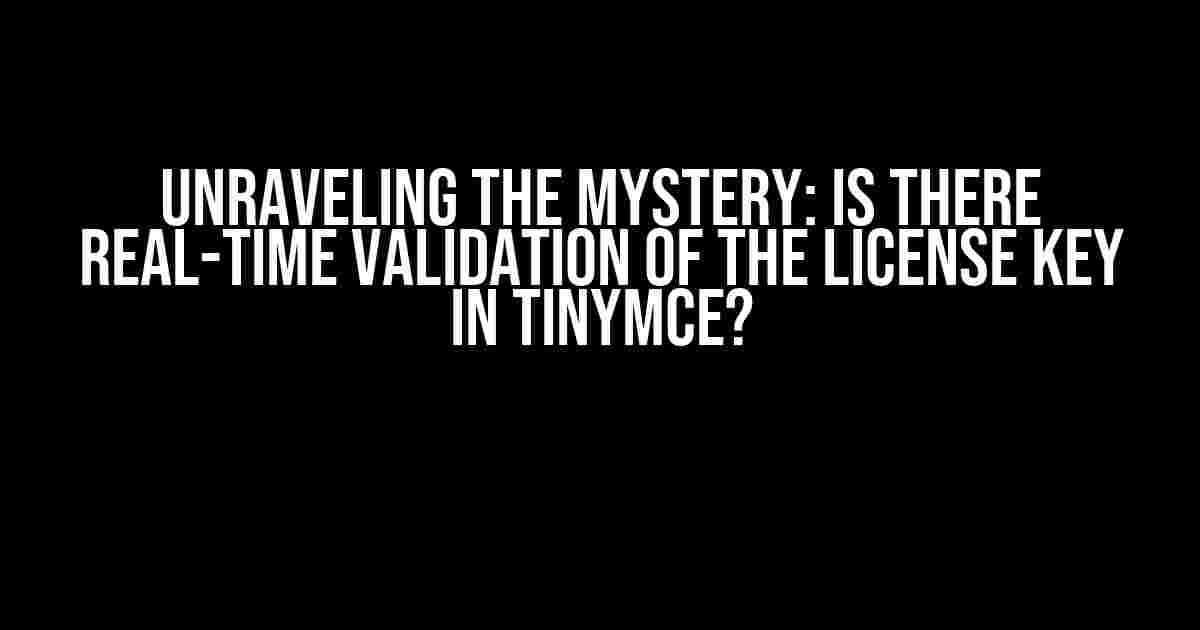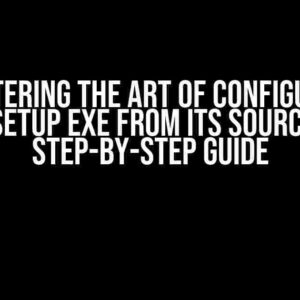TinyMCE, the popular rich-text editor, has been a staple in the web development community for years. With its user-friendly interface and extensive feature set, it’s no wonder why developers flock to it. However, one crucial aspect often raises questions among users: license key validation. In this article, we’ll delve into the world of TinyMCE licensing and answer the burning question: Is there real-time validation of the license key in TinyMCE?
What is a License Key in TinyMCE?
Before we dive into the main topic, let’s take a step back and understand what a license key is in the context of TinyMCE. A license key is a unique string of characters provided by TinyMCE when you purchase a commercial license. This key is used to activate the premium features of the editor, such as advanced plugins, support, and customization options.
Why is License Key Validation Important?
License key validation is a crucial aspect of using TinyMCE, as it ensures that you’re using the software legitimately and in compliance with the licensing terms. Without proper validation, you might be missing out on essential features or, worse, infringing on TinyMCE’s intellectual property.
Real-Time Validation of License Key in TinyMCE: The Truth Revealed
So, is there real-time validation of the license key in TinyMCE? The short answer is: it depends. TinyMCE offers two types of license validation mechanisms:
- Server-side validation: This method involves validating the license key on your server, typically during the installation or configuration process. This approach ensures that the license key is verified before the editor is initialized.
- Client-side validation: This method involves validating the license key within the client-side JavaScript code, typically when the editor is initialized. This approach is more lightweight and easier to implement, but it might not provide the same level of security as server-side validation.
In terms of real-time validation, TinyMCE does not perform strict, continuous validation of the license key. Instead, it relies on periodic checks or manual validation triggers. This means that if you’re using a invalid or expired license key, TinyMCE might not immediately detect it.
Implementing Real-Time License Key Validation in TinyMCE
While TinyMCE doesn’t provide built-in real-time license key validation, you can still implement a custom solution to achieve this. Here’s a high-level overview of the steps involved:
- Store the license key securely: Store the license key in a secure, encrypted manner to prevent unauthorized access. You can use a secure key-value store or a dedicated license management system.
- Create a validation endpoint: Develop a server-side endpoint that takes the license key as input and returns a validation result (e.g., valid or invalid). This endpoint should be securely authenticated and authorized.
- Configure TinyMCE to call the validation endpoint: Modify the TinyMCE initialization code to call the validation endpoint and pass the license key as a parameter. You can use the
tinymce.initmethod to achieve this. - Handle validation results: Handle the validation result returned by the endpoint. If the license key is invalid, you can display an error message, disable premium features, or take other appropriate actions.
Here’s some sample code to give you an idea of how this could be implemented:
tinymce.init({
selector: '#myEditor',
-licenseKey: 'YOUR_LICENSE_KEY',
validationURL: 'https://your-validation-endpoint.com/validate',
validationCallback: function(result) {
if (result.valid) {
console.log('License key is valid!');
} else {
console.log('License key is invalid!');
// Disable premium features or display an error message
}
}
});
Best Practices for License Key Management in TinyMCE
To ensure seamless license key management and validation, follow these best practices:
- Store the license key securely: Use a secure key-value store or a dedicated license management system to store the license key.
- Use a valid license key: Ensure that the license key is valid, up-to-date, and matches the number of users or domains specified in the licensing agreement.
- Implement periodic validation: Schedule regular validation checks to ensure the license key remains valid and hasn’t been tampered with.
- Monitor license key usage: Keep track of license key usage and alert administrators if unusual activity is detected.
Conclusion
In conclusion, while TinyMCE doesn’t provide built-in real-time license key validation, you can implement a custom solution to achieve this. By following the steps outlined in this article and adhering to best practices, you can ensure seamless license key management and validation in your TinyMCE implementation.
| License Key Validation Method | Description | Real-Time Validation |
|---|---|---|
| Server-side validation | Validates the license key on the server during installation or configuration | Limited |
| Client-side validation | Validates the license key within the client-side JavaScript code | Limited |
| Custom implementation | Implements real-time license key validation using a custom solution | Achievable |
By understanding the nuances of license key validation in TinyMCE, you can ensure a smooth and compliant experience for your users. Remember, a valid license key is the key to unlocking the full potential of TinyMCE!
Frequently Asked Question
Get the scoop on TinyMCE’s license key validation!
Is there real-time validation of the license key in TinyMCE?
Yes, TinyMCE does perform real-time validation of the license key. As soon as you enter a license key, it’s validated against our licensing servers to ensure it’s authentic and eligible for use.
Will I be notified if my license key is invalid or expired?
Absolutely! If your license key is invalid or expired, you’ll receive an error message or notification within TinyMCE, so you can take prompt action to resolve the issue.
Can I use TinyMCE without a valid license key?
No, a valid license key is required to use TinyMCE. If you don’t have a valid license key, you won’t be able to access the editor’s features and functionality.
How often does TinyMCE check the license key?
TinyMCE checks the license key upon initialization and periodically thereafter to ensure it remains valid and eligible for use. This frequency may vary depending on your specific implementation and configuration.
What happens if my license key is blocked or blacklisted?
If your license key is blocked or blacklisted, you’ll receive an error message indicating the issue. In this case, you’ll need to contact our support team to resolve the problem and obtain a new, valid license key.


